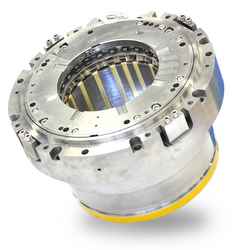
Posted to News on 8th Jul 2016, 16:10
Magnetic bearings tough enough for the depths of the sea
Today's oil and gas industry is facing many challenges, including lower oil prices and environmental issues that are forcing companies to look into alternative methods of extraction. Many companies are recognising the need to innovate and are investing in long-term solutions.

Energy company Statoil is one of these innovative companies. It has understood the importance of being at the forefront of technology for cost cutting, environmental reasons and its long-term survival. Torstein Vinterstø, Statoil's Project Director for sgard says: "We realised that we needed to think differently when it came to the technology and turn every stone to bring down costs and cut our CO2 emissions."
For years Statoil has been working on the technology behind the world's first-ever subsea gas compression system. In September 2015, it lowered its sgard subsea gas compression system in the North Sea, making it possible to recover more gas from the offshore fields up to unprecedented ratios.
Traditionally, gas compression takes place on platforms or onshore, quite a distance from the source. Locating a compressor as close to the well as possible offers a cheaper and more energy-efficient alternative. It saves space, cuts down on maintenance and because it is unmanned and can be operated remotely, it removes the need for constant supervision and personnel.
The subsea gas compression system is located on the seabed in the sgard gas field 300 metres deep in the North Sea. Recovery from sgard's two reservoirs, Midgard and Mikkel, will increase by at least 20 per cent, adding more than 300 million barrels of oil equivalents to the field's output. The system will significantly prolong the lifetime of the field's production. Without the new system, these reservoirs would have closed down prematurely and Statoil would have been forced to find other reserves.
Moreover, there are impressive environmental benefits. The subsea compressor requires some 40 per cent less power to operate than a traditional topside system for the same service and it significantly reduces the CO2 emissions of a field. SKF's magnetic bearing technology was a key enabler in turning this dream into a reality. Vinterstø says: "We chose SKF for their strength in bearings. It is the only company on the market with such a qualified product."
Smart magnetic bearing technology
Statoil and SKF have shared a long relationship that dates back to the 1980s and the two companies worked closely on the smart magnetic bearing technology, which is integrated inside the compressor casing. Engineers from both SKF and Statoil often worked side-by side with SKF coming up with ideas and suggesting ways to cut costs. Vinterstø says: "We had a lot of discussions and I think that this way of sharing gave them a better understanding of our end-user needs and lead to a better result."
SKF's magnetic bearings spin without making contact. This contact-free design is lubrication free, energy efficient and enables low vibration. The bearings can run continuously and control shafts rotating at very high speed, typically above critical modes not reachable by other bearings.
All of these factors were important when designing the subsea gas compression system. Keeping the system architecture simple, with as few components as possible, was vital due to space, weight and environmental considerations.
The magnetic bearings are integrated inside the electric motor driven compressor's casing, eliminating the need for lubricating oil, seals and a gearbox. The frictionless magnetic bearings enable higher rotation speeds leading to smaller and lighter compressor modules and infrastructure.
SKF's deep knowledge of high rotation speeds and how magnetic bearings function in industrial processes gave it the edge when designing the new application, but getting the technology to meet a host of regulations was a time-consuming process. The project took 5 years of intense development and testing, including simulating underwater sea conditions above ground in 6000 hours of continual operation.
J©r©my Lepelley, Subsea & Oil & Gas Developments Sales Manager, at SKF Magnetic Mechatronics says: "Before the customer agreed to the bearings solution we did a topside version of the system to make sure that the components were suitable for the underwater environment. This helped us achieve top quality and meet the specifications for vibrations and more. We learned a lot with the Statoil project which moves us up in terms of technology and gives us an edge over the competition."
There are many more applications for SKF's magnetic bearings in the oil, gas and power generation industries. The bearings can be found onshore, offshore - and now subsea. Magnetic bearings are in industrial cooling chillers, blowers, pumps - everywhere there is a system rotating at high speed or where there is a need to cut down on CO2 emissions. For more information please visit www.skf.co.uk






























